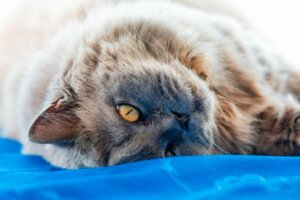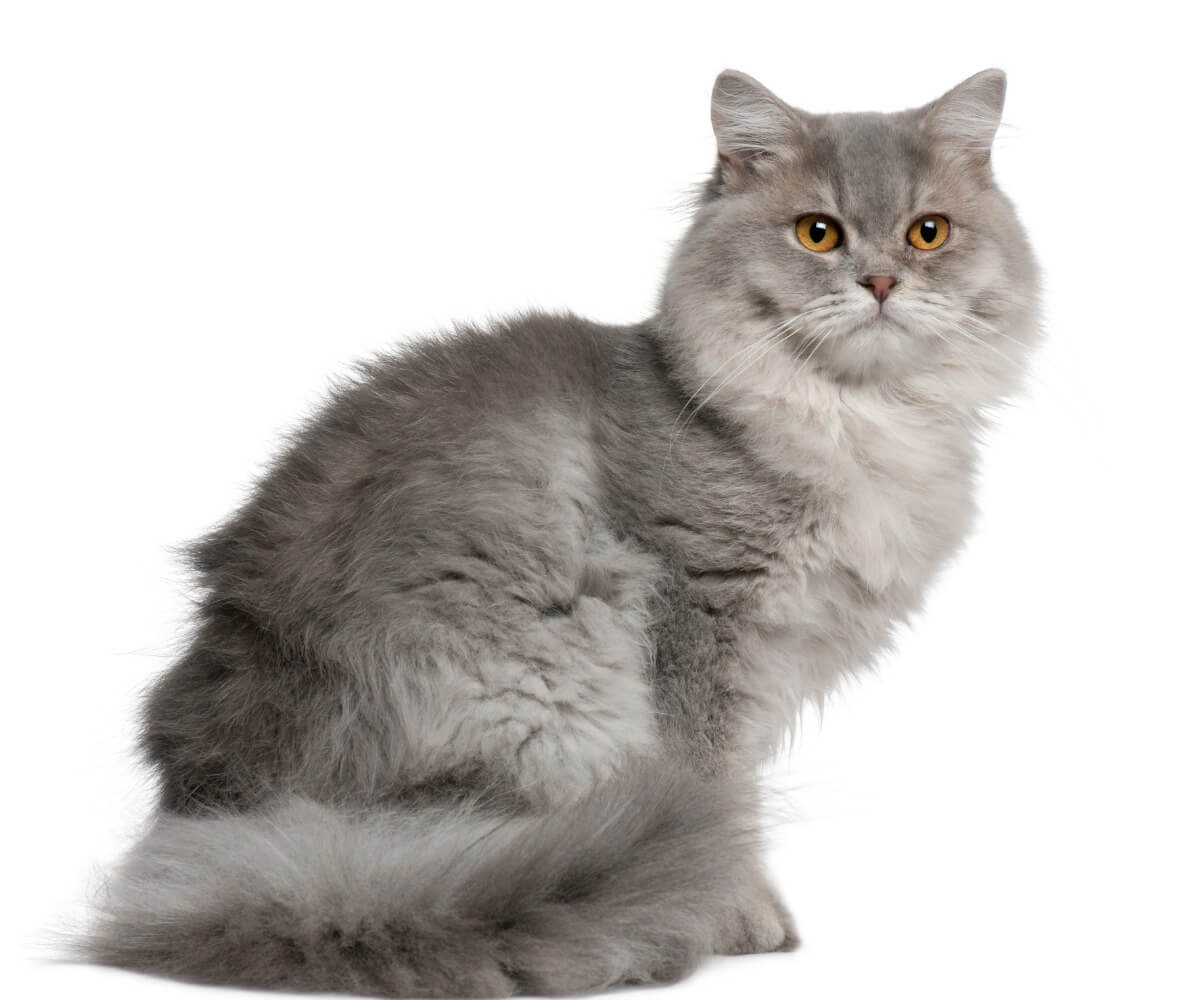British Longhair Cat: Origin and Characteristics


Written and verified by the biologist Francisco Morata Carramolino
When looking for a cat to adopt as a companion, the variety of breeds can make the choice very difficult. In today’s article, we’ll be bringing you a highly recommended breed, the British longhair cat.
These cats were accidentally created in the 20th century and are in the process of being recognized as a breed of their own. If you’re looking for a feline companion and want to know more about the British longhair cat, then read on!
Origin of the British longhair cat
British cats come from the felids that accompanied the Romans when they colonized Britain. These animals were originally imported from Egypt.
From these ancient animals, the breed of British shorthair cats was established, which has remained very popular and has hardly altered over time. However, their survival hasn’t always been guaranteed.
With the advent of the First World War, and even more so after the Second World War, the British Shorthair gene pool was severely reduced. In order to provide genetic variability and save the breed, breeders began to cross the surviving specimens with Persian cats.
These cats carried the gene for long hair, but this gene is recessive, as indicated by specialized portals. This means that, for the offspring to have long hair, both of their parents must carry this gene. Therefore, the majority of cats that emerged from these initial crosses were identical to the usual short-haired felines.
However, with the passage of time, long-haired cats began to appear. As the recessive gene began to become more common among the new generations of Shorthairs, the traits of the British longhair cat began to become more and more relevant.
Although initially rejected, the British longhair cat is an increasingly recognized and beloved breed. However, like so many other events in nature, it came about completely unintentionally.

Physical characteristics
Due to its origin, the British longhair cat shares many of its characteristics with its short-haired ancestor. They’re medium-sized or large felines, with a long dense coat that makes them appear even more imposing. They’re generally quite stocky and broad, with strong short legs and a thick tail.
The head is large and rounded, with a short muzzle. The whisker pads are quite prominent and rounded, as is the chin. The eyes are large, very circular, and open, and the ears are short and rounded.
As with the British shorthair, this cat has a wide variety of colors. Some individuals have a single shade throughout the body, while others boast very different combinations.
- Tortie: This 3-color pattern is reminiscent of a tortoiseshell cat. Torties are usually female.
- Colorpoint: The cat is generally white throughout, with the tips of the legs, tail, nose, and ears darker.
- Tabby: This characteristic pattern consists of a base color crossed by a series of darker irregular stripes.
British longhair cat character
These felines are friendly and affectionate, but they also maintain their independence. Although they don’t constantly depend on their owners, they do enjoy human company. They often prefer to be in the same room as people, play games, or snuggle with them. However, they’re also comfortable spending time on their own.
This breed is generally calm and collected. They aren’t particularly active cats, but they are curious. They enjoy games that provide mental stimulation, love food, and are usually not very loud. Furthermore, this personality makes them compatible with very different family situations. They tolerate coexistence with children, dogs, and the elderly very well.
British longhair cat care
This breed requires very similar care to other domestic cats, with two aspects of special interest. For one thing, the long coat needs more maintenance than other short-haired breeds. If left unattended, it can quickly become tangled and accumulate dirt, which is annoying to the animal and can lead to health problems. To avoid this, it’s highly recommended to brush the cat every week.
And, as we touched on before, these felines aren’t very active and yet they’re enthusiastic about food. As you can imagine, this makes them prone to obesity. It’s very important to ensure that these cats get enough exercise and a suitable diet.
It should be noted that letting the feline roam freely outside the house is not a good option. Although you would exercise that way, it must be remembered that cats are invasive species that cause very severe damage to local biodiversity. A better alternative, for them, and for nature, is to get them to exercise inside the home.
Diseases
Like all purebreds or crosses sustained over time, the British longhair cat has a predisposition to certain illnesses and conditions. Among them, we can highlight the following:
- Hyperthyroidism: A condition that occurs when the thyroid gland is overstimulated and produces too many hormones. Some sources argue that this pathology is typical of British longhair cats, but research has found that they are less at risk than Shorthairs of developing it.
- Hypertrophic cardiomyopathy – A pathology characterized by atypical thickening of the left ventricle of the heart. In this case, it’s a condition more likely to occur in the British longhair cat than in other breeds.
- Polycystic kidney disease: In this condition, non-cancerous cysts occur in the feline’s kidneys, slowly but steadily. Persian cats are undoubtedly the most affected by this disease, but the British longhairs aren’t spared, as many cases have been recorded and genotyped.

British longhair cats are beautiful, loyal, playful, and have an imposing appearance. However, like any other breed crossed over time between relatives to obtain the desired traits, there are certain health problems that must be taken into account.
When looking for a cat to adopt as a companion, the variety of breeds can make the choice very difficult. In today’s article, we’ll be bringing you a highly recommended breed, the British longhair cat.
These cats were accidentally created in the 20th century and are in the process of being recognized as a breed of their own. If you’re looking for a feline companion and want to know more about the British longhair cat, then read on!
Origin of the British longhair cat
British cats come from the felids that accompanied the Romans when they colonized Britain. These animals were originally imported from Egypt.
From these ancient animals, the breed of British shorthair cats was established, which has remained very popular and has hardly altered over time. However, their survival hasn’t always been guaranteed.
With the advent of the First World War, and even more so after the Second World War, the British Shorthair gene pool was severely reduced. In order to provide genetic variability and save the breed, breeders began to cross the surviving specimens with Persian cats.
These cats carried the gene for long hair, but this gene is recessive, as indicated by specialized portals. This means that, for the offspring to have long hair, both of their parents must carry this gene. Therefore, the majority of cats that emerged from these initial crosses were identical to the usual short-haired felines.
However, with the passage of time, long-haired cats began to appear. As the recessive gene began to become more common among the new generations of Shorthairs, the traits of the British longhair cat began to become more and more relevant.
Although initially rejected, the British longhair cat is an increasingly recognized and beloved breed. However, like so many other events in nature, it came about completely unintentionally.

Physical characteristics
Due to its origin, the British longhair cat shares many of its characteristics with its short-haired ancestor. They’re medium-sized or large felines, with a long dense coat that makes them appear even more imposing. They’re generally quite stocky and broad, with strong short legs and a thick tail.
The head is large and rounded, with a short muzzle. The whisker pads are quite prominent and rounded, as is the chin. The eyes are large, very circular, and open, and the ears are short and rounded.
As with the British shorthair, this cat has a wide variety of colors. Some individuals have a single shade throughout the body, while others boast very different combinations.
- Tortie: This 3-color pattern is reminiscent of a tortoiseshell cat. Torties are usually female.
- Colorpoint: The cat is generally white throughout, with the tips of the legs, tail, nose, and ears darker.
- Tabby: This characteristic pattern consists of a base color crossed by a series of darker irregular stripes.
British longhair cat character
These felines are friendly and affectionate, but they also maintain their independence. Although they don’t constantly depend on their owners, they do enjoy human company. They often prefer to be in the same room as people, play games, or snuggle with them. However, they’re also comfortable spending time on their own.
This breed is generally calm and collected. They aren’t particularly active cats, but they are curious. They enjoy games that provide mental stimulation, love food, and are usually not very loud. Furthermore, this personality makes them compatible with very different family situations. They tolerate coexistence with children, dogs, and the elderly very well.
British longhair cat care
This breed requires very similar care to other domestic cats, with two aspects of special interest. For one thing, the long coat needs more maintenance than other short-haired breeds. If left unattended, it can quickly become tangled and accumulate dirt, which is annoying to the animal and can lead to health problems. To avoid this, it’s highly recommended to brush the cat every week.
And, as we touched on before, these felines aren’t very active and yet they’re enthusiastic about food. As you can imagine, this makes them prone to obesity. It’s very important to ensure that these cats get enough exercise and a suitable diet.
It should be noted that letting the feline roam freely outside the house is not a good option. Although you would exercise that way, it must be remembered that cats are invasive species that cause very severe damage to local biodiversity. A better alternative, for them, and for nature, is to get them to exercise inside the home.
Diseases
Like all purebreds or crosses sustained over time, the British longhair cat has a predisposition to certain illnesses and conditions. Among them, we can highlight the following:
- Hyperthyroidism: A condition that occurs when the thyroid gland is overstimulated and produces too many hormones. Some sources argue that this pathology is typical of British longhair cats, but research has found that they are less at risk than Shorthairs of developing it.
- Hypertrophic cardiomyopathy – A pathology characterized by atypical thickening of the left ventricle of the heart. In this case, it’s a condition more likely to occur in the British longhair cat than in other breeds.
- Polycystic kidney disease: In this condition, non-cancerous cysts occur in the feline’s kidneys, slowly but steadily. Persian cats are undoubtedly the most affected by this disease, but the British longhairs aren’t spared, as many cases have been recorded and genotyped.

British longhair cats are beautiful, loyal, playful, and have an imposing appearance. However, like any other breed crossed over time between relatives to obtain the desired traits, there are certain health problems that must be taken into account.
All cited sources were thoroughly reviewed by our team to ensure their quality, reliability, currency, and validity. The bibliography of this article was considered reliable and of academic or scientific accuracy.
- https://www.tica.org/breeds/browse-all-breeds?view=article&id=828:british-longhair-breed&catid=79
- https://www.zooplus.co.uk/magazine/cat/cat-breeds/the-british-longhair
- https://wamiz.co.uk/cat/breeds/475/british-longhair
- Longhair, UCdavis, Veterinary Medicine. Recogido a 6 de junio en https://vgl.ucdavis.edu/test/long-hair-catCa
- Mary, J., Chetboul, V., Sampedrano, C. C., Abitbol, M., Gouni, V., Trehiou-Sechi, E., … & Thomas, A. (2010). Prevalence of the MYBPC3-A31P mutation in a large European feline population and association with hypertrophic cardiomyopathy in the Maine Coon breed. Journal of Veterinary Cardiology, 12(3), 155-161.
- Peterson, M. E. (2015). Primary goitrous hypothyroidism in a young adult domestic longhair cat: diagnosis and treatment monitoring. Journal of Feline Medicine and Surgery Open Reports, 1(2), 2055116915615153.
- Krasnoselskaya, S., & Silaev, P. (2020). STANDARDIZATION OF INDIVIDUAL GROUPS OF GOLD-TIPPED CAT COLORS. American Scientific Journal, (39-1), 4-10.
This text is provided for informational purposes only and does not replace consultation with a professional. If in doubt, consult your specialist.








